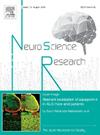Enhancement of beta rebound elicited by proprioceptive stimulation in the sensorimotor cortex by transcranial alternating current stimulation matched to the dominant beta frequency
IF 2.4
4区 医学
Q3 NEUROSCIENCES
引用次数: 0
Abstract
Transcranial alternating current stimulation (tACS) can modulate endogenous brain oscillations in a frequency-specific manner. Previous studies have reported that beta tACS modulates the excitability of primary motor cortex and improves task performance. Tactile and proprioceptive stimuli also elicit event-related synchronization of the beta rhythm in contralateral sensorimotor cortex, termed beta rebound, and a strong correlation was reported between proprioception-induced rebound strength and clinical recovery in stroke patients. We investigated the effects of tACS matched to the dominant beta frequency on the strength of proprioception-induced beta rebound.We recorded the beta rebound from 14 healthy young adults in response to passive index finger movement by electroencephalography to determine individual peak beta frequency. Electroencephalograms (EEG) were recorded during passive movements before and after active or sham tACS. We recorded beta rebound of all participants to determine their individual peak frequency of beta rebound prior to this experiment. Active tACS at individually matched frequencies increased beta rebound strength during subsequent passive movement compared to sham tACS in the majority of participants, while the remaining participants demonstrated no significant change or a decrease. These findings on healthy participants provide an essential foundation for further studies on the effects of beta frequency-matched tACS for stroke patient rehabilitation.
经颅交流电刺激对感觉运动皮层本体感觉刺激诱发的β反弹的增强。
经颅交流电刺激(tACS)可以以特定频率的方式调节内源性脑振荡。先前的研究已经报道了β - tACS调节初级运动皮层的兴奋性并提高任务表现。触觉和本体感觉刺激也会引起对侧感觉运动皮层β节律的事件相关同步,称为β反弹,并且报道了本体感觉诱导的反弹强度与中风患者的临床恢复之间的强相关性。我们研究了与β显性频率匹配的tACS对本体感觉诱导的β反弹强度的影响。我们用脑电图记录了14名健康年轻人被动食指运动时的β反弹,以确定个体的峰值频率。记录患者在主动或假性tac前后被动运动时的脑电图。在实验之前,我们记录了所有参与者的β反弹,以确定他们个人的β反弹峰值频率。与假tACS相比,单独匹配频率的主动tACS在随后的被动运动中增加了β反弹强度,而其余参与者没有表现出明显的变化或下降。这些健康参与者的研究结果为进一步研究频率匹配tACS对脑卒中患者康复的影响提供了必要的基础。
本文章由计算机程序翻译,如有差异,请以英文原文为准。
求助全文
约1分钟内获得全文
求助全文
来源期刊

Neuroscience Research
医学-神经科学
CiteScore
5.60
自引率
3.40%
发文量
136
审稿时长
28 days
期刊介绍:
The international journal publishing original full-length research articles, short communications, technical notes, and reviews on all aspects of neuroscience
Neuroscience Research is an international journal for high quality articles in all branches of neuroscience, from the molecular to the behavioral levels. The journal is published in collaboration with the Japan Neuroscience Society and is open to all contributors in the world.
 求助内容:
求助内容: 应助结果提醒方式:
应助结果提醒方式:


